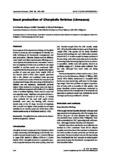Seed production of Charybdis feriatus (Linnaeus)
Share
စိတ္တဇ
Some aspects of the reproductive biology of Charybdis feriatus (Linnaeus) were investigated to identify suitable techniques for broodstock management and seed production. Likewise, factors such as ablation, water depth and light requirements affecting survival or reproductive performance were tested. Production of megalops in tanks and juveniles in net cages installed in earthen ponds was conducted. Wild-caught berried females produced a significantly higher number of zoeae per gram body weight (BW) of the female (3300±600) than captive spawners (867±58). Ablated and unablated crabs spawned after a month and ovaries of both had oocytes in all developmental stages after spawning, indicating that ablation was not necessary. Broodstock survived higher when stocked in 1 m-deep water and kept in dark conditions compared with shallow (0.5 m depth) water or ambient lighting. There were six zoea and one megalopa stage. Megalops were produced (survival of 2–22% in 1 tonne or 23–55% in 3 L tanks) when methods for the mud crab Scylla serrata (Forsskål) were used, but feeding with Artemia started only at the Z4 stage. Survival of megalops after 1 month was higher when stocked in net cages installed in an earthen pond (32–82%) than when reared continuously in land-based tanks (5–11%).
Suggested Citation
Parado-Estepa, F. D., Quinitio, E. T., & Rodriguez, E. (2007). Seed production of Charybdis feriatus (Linnaeus). Aquaculture Research , 38(14), 1452-1458. https://doi.org/10.1111/j.1365-2109.2007.01724.x
ဘာသာရပ်
ablation  ; aquaculture
; aquaculture  ; breeding stock
; breeding stock  ; cages; developmental stages
; cages; developmental stages  ; Megalops; ponds
; Megalops; ponds  ; seed production
; seed production  ; zoeae
; zoeae  ; larvae
; larvae  ; Artemia
; Artemia  ; Charybdis feriatus
; Charybdis feriatus  ; Decapoda
; Decapoda  ; Scylla serrata
; Scylla serrata  ; Megalops
; Megalops  ; Broodstock management; crabs
; Broodstock management; crabs 
 ; aquaculture
; aquaculture  ; breeding stock
; breeding stock  ; cages; developmental stages
; cages; developmental stages  ; Megalops; ponds
; Megalops; ponds  ; seed production
; seed production  ; zoeae
; zoeae  ; larvae
; larvae  ; Artemia
; Artemia  ; Charybdis feriatus
; Charybdis feriatus  ; Decapoda
; Decapoda  ; Scylla serrata
; Scylla serrata  ; Megalops
; Megalops  ; Broodstock management; crabs
; Broodstock management; crabs 
Taxonomic term
စုစည်းမှုများ စုစည်းမှုများ
- AQD Journal Articles [1215]


